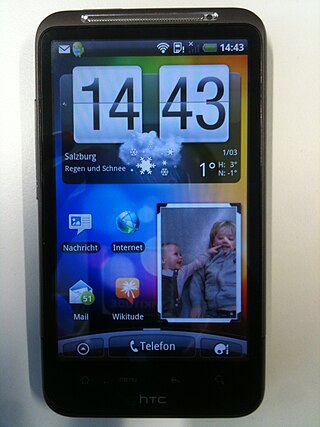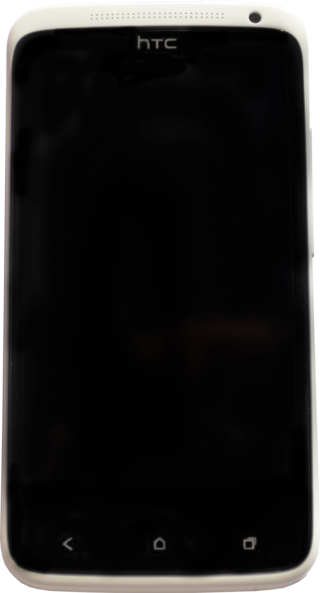
HTC Hero is the third phone manufactured by HTC running the Android platform, announced on June 24, 2009 in London.
Motoblur is a discontinued Android user interface and push-based service focused on social networking, developed by Motorola.

HTC is the original design manufacturer for many Android and Windows Phone-based smartphones and PDAs. Brands that have marketed or previously marketed HTC-manufactured products include Dell, Fujitsu Siemens, HP/Compaq, i-mate, Krome, O2, Palm, Sharp Corporation, and UTStarcom. HTC also manufactures ultra-mobile PCs, and is also the manufacturer of the Nexus One and Nexus 9, a smartphone and tablet designed and branded by Google, respectively.

The HTC Evo 4G is a smartphone developed by HTC Corporation and marketed as Sprint's flagship Android smartphone, running on its WiMAX network. The smartphone was launched on June 4, 2010. It was the first 4G enabled smartphone released in the United States.

The HTC Droid Incredible (ADR6300) is a smartphone manufactured by HTC Corporation using the Android operating system. It was released on April 29, 2010, and is available through Verizon Wireless only. The device is similar to the Sprint HTC Evo 4G. The device has been succeeded by the HTC Incredible S and the HTC ThunderBolt. The device was discontinued in March 30, 2011.

The HTC Desire HD is an Android smartphone by HTC Corporation. It was unveiled at a press event in London hosted by HTC on September 15, 2010, and was made available for sale in October in Europe and in January 2011 in Canada. The Desire was HTC's fourth flagship Android device until the release of their new line of flagship model, the HTC Sensation.

The HTC ThunderBolt (ADR6400L) was the first 4G LTE smartphone on the Verizon Wireless network. It is a CDMA/LTE variant of the HTC Desire HD. It was first announced at CES on January 6, 2011.
The HTC Evo Shift 4G is a smartphone developed by HTC Corporation and marketed as the concurrent/sequel to Sprint's flagship Android smartphone, running on its 4G WiMAX network. The smartphone launched on January 9, 2011.

The HTC Evo 3D is a 3D-enabled Android smartphone developed by HTC, released exclusively in the United States through Sprint, and was re-released as a pre-paid smartphone by Virgin Mobile in May 2012 as the HTC Evo V 4G. A variation of Sprint's flagship HTC Evo 4G, the device is distinguished by its pair of 5 MP rear cameras, which made the Evo 3D the first cell phone to do so, which can be used to take photos or video in stereographic 3D, which can be viewed on its autostereoscopic display without the need for 3D glasses. Several GSM variants are also available in Canada, Europe and Asia.

The HTC Sensation is a smartphone designed and manufactured by HTC Corporation that runs the Android 2.3 Gingerbread software stock. Officially announced by HTC on April 12, 2011, the HTC Sensation was launched by Vodafone in key European markets including the United Kingdom on May 19, 2011 and by T-Mobile in the United States on June 12, 2011. It was HTC's fifth flagship Android phone and the first HTC phone to support the HTC Sense 3.0 user interface. At the time of its release, the Sensation XE was the world's fastest Android phone.

The HTC Incredible S (S710E) (s710d), also known as the Incredible 2, is a smartphone designed and manufactured by Taiwan's HTC Corporation originally running the Android 2.2 operating system. Officially announced by HTC on February 15, 2011 at MWC 2011 in Barcelona, Spain, alongside the HTC Desire S and the HTC Wildfire S, the HTC Incredible S was launched exclusively in the UK to Carphone Warehouse and Best Buy on February 26, 2011 marketed by Sarah Harding of Girls Aloud.

The LG Optimus 3D is a 3D-enabled Android 2.2 Froyo 3D mobile device released on 7 July 2011 in the UK and advertised as the world's first full 3D mobile phone. It has 512 MB of RAM and 8 GB of onboard storage, which can be expanded by up to 32 GB using a micro SDHC card. The phone features two 5 MP back-facing cameras that are capable of filming 720p 3D and Full HD 1080p in 2D, while pictures taken in 2D mode are 5 MP and 3 MP when taking a 3D picture. It also includes a VGA front-facing camera for video-calling. The phone features a 3D user interface which allows the users to access 3D content, such as YouTube in 3D, 3D games and apps, or 3D gallery with a push of a button.

The HTC One X is a touchscreen-based, slate-sized smartphone designed and manufactured by HTC. It was released running Android 4.0.3, with the HTC Sense 4.0 skin. The One X is powered by the NVIDIA Tegra 3 for most international GSM carriers, making this the first HTC phone to be equipped with a quad-core processor, while a variant which is LTE capable is powered by the Qualcomm Snapdragon S4 dual-core 1.5 GHz Krait processor. The One X was announced on February 26, 2012, at the Mobile World Congress and was HTC's sixth flagship product, leading the HTC One series from the time of its release through April 2013, when its successor the HTC One (M7) was announced.

The HTC EVO Design 4G is an Android powered smartphone released by Sprint Nextel on October 23, 2011 and by Boost Mobile on May 30, 2012. It is the fourth HTC phone in their EVO line. Notable features include a qHD display, an aluminum semi-monocoque form, world phone connectivity (multi-band), and a smaller overall size compared to most Android phones. The single-core processor and questionable battery life have left the phone with a mixed reception. The EVO Design 4G is also Sprint's last 4G phone utilizing its WiMAX network.

The HTC Evo 4G LTE is an Android smartphone developed by HTC Corporation to be released exclusively by Sprint. A successor to the previous HTC Evo 4G and 3D models, the Evo 4G LTE supports Sprint's LTE cellular network and its current-generation EV-DO network. The Evo 4G LTE shares features with its GSM counterpart, the HTC One X—such as the same dual-core 1.5 GHz processor used by the One X's LTE variant, a 4.7-inch screen, and Android 4.1 with HTC's Sense 4.0 interface. The Evo 4G LTE was also the first phone built with an all aluminum frame, leaving only a small plastic piece to allow the Sim and micro sd cards to be installed.
HTC One is a series of Android and Windows Phone smartphones designed and manufactured by HTC. All products in the One series were designed to be touchscreen-based and slate-sized, and to initially run the Android mobile operating system with the HTC Sense graphical user interface. The one exception to this is the HTC One (M8), which also had a Windows Phone variant. From 2010 to 2013, all HTC products starting from the HTC Sensation XE to the HTC One Mini were equipped with a Beats Audio equalizer. Later HTC devices beginning with the HTC One Max no longer ship with Beats Audio following the buyback of HTC's stake in Beats Electronics.
The HTC Rhyme is a multi-touch, slate-format Android 2.3 smartphone designed and produced by HTC. The Rhyme was released in the United States exclusively by Verizon Wireless on September 22, 2011, with releases in Asia and Europe beginning in October 2011. The Rhyme is a mid-range smartphone, distinguished by its use of an updated HTC Sense 3.5 user experience, and a selection of bundled accessories; such as a charging dock, wireless speakers, and an LED "charm" that can be used as a notification light. While it was not explicitly marketed as such by HTC, the Rhyme was primarily developed and targeted towards women.

HTC One is a touchscreen-based Android smartphone designed, developed, and manufactured by HTC. The smartphone was unveiled on 19 February 2013 at press events in New York City and London and is HTC's seventh flagship smartphone. It has been hailed by many as a revolutionary Android handset with its premium design and build quality and its emphasis on high end audio. It is the successor to the company's 2012 flagship model, the One X—which was critically acclaimed, but commercially unsuccessful due in part to insufficient marketing efforts. To make the device stand out among its competition, HTC One was developed with a major emphasis on unique hardware and software features; which included a unibody aluminum frame, a 1080p full-HD display, dual front-facing stereo speakers, a camera with a custom image sensor and the ability to automatically generate montages of media, an updated version of HTC's Sense user experience, BlinkFeed—an aggregator of news and social network content, and an electronic program guide app with the ability to serve as a universal remote via an IR blaster located in the device's power button.
A lock screen is a computer user interface element used by various operating systems. They regulate immediate access to a device by requiring the user to perform a certain action in order to receive access, such as entering a password, using a certain button combination, or performing a certain gesture using a device's touchscreen. There are various authentication methods to get past the lock screen, with the most popular and common ones being personal identification numbers (PINs), the Android pattern lock, and biometrics.

The HTC One (M8) is an Android or Windows smartphone manufactured and marketed by HTC. Following a number of leaks that occurred during the months prior, the device was officially unveiled in a press conference on March 25, 2014, and released the same day by Verizon Wireless at retail, and by other Canadian and United States carriers for online orders prior to its wider retail availability in mid-April.













